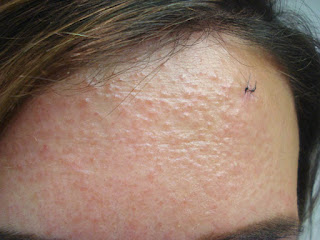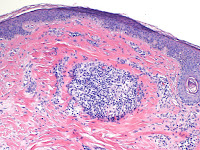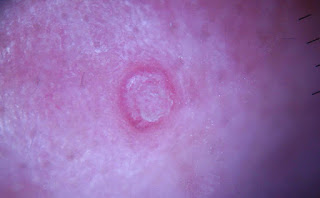The patient is a 43
yo Hispanic female. with several months of bleeding gums, sloughing tissue, and
generalized oral pain. She is otherwise
healthy and takes no meds or supplements.
She has no skin or vaginal lesions.
Lab: Normal
CBC and metabolic panel.
Her oral surgeon did a biopsy biopsy of normal mucosa adjacent to sloughing attached gingiva on anterior mandible and sent this for direct immunoflouresence (DIF).
Her oral surgeon did a biopsy biopsy of normal mucosa adjacent to sloughing attached gingiva on anterior mandible and sent this for direct immunoflouresence (DIF).
Clinical Image:
Path:
H&E:
Acantholysis
DIF: Intercellular deposition of C3 and IgG.
Diagnosis: Pemphigus vulgaris
Questions:
This patient does not live close to an academic center and travel there would be difficult.
Does it make sense to initiate therapy with rituximab (if her insurance covers that) + prednisone. or should therapy be initiated with prednisone and conventional adjunctive added later if nexessary?
References:
Questions:
This patient does not live close to an academic center and travel there would be difficult.
Does it make sense to initiate therapy with rituximab (if her insurance covers that) + prednisone. or should therapy be initiated with prednisone and conventional adjunctive added later if nexessary?
References:
1. First-line rituximab combined with short-term prednisone
versus prednisone alone for the treatment of pemphigus (Ritux 3): a
prospective, multicentre, parallel-group, open-label randomised trial.
Joly P. et. al. Lancet.
2017 May 20;389(10083):2031-2040.
This is a paper by the French study group on autoimmune bullous
skin diseases.
CONCLUSIONS: 32.5% of our patients with moderate to severe
pemphigus vulgaris failed prednisone and traditional CAT treatment and required
rituximab therapy. Rituximab reduced the monthly prednisone intake in these
patients by 73%. This suggests that a subset of patients with moderate to
severe pemphigus may benefit from early institution of rituximab therapy.
Rituximab significantly reduces the monthly prednisone requirement among
CAT-resistant pemphigus vulgaris patients to levels on par with CAT-responsive
patients.
2. Comparison of rituximab and conventional adjuvant therapy
for pemphigus vulgaris: A retrospective analysis.
Agarwal A, Hall RP 3rd, Bañez LL, Cardones AR.
PLoS One. 2018 Sep 25;13(9):e0198074. Free PMC Article
CONCLUSIONS: 32.5% of our patients with moderate to severe
pemphigus vulgaris failed prednisone and traditional CAT treatment and required
rituximab therapy. Rituximab reduced the monthly prednisone intake in these
patients by 73%. This suggests that a subset of patients with moderate to
severe pemphigus may benefit from early institution of rituximab therapy.
Rituximab significantly reduces the monthly prednisone requirement among
CAT-resistant pemphigus vulgaris patients to levels on par with CAT-responsive
patients.
3.
3.
JAMA Dermatol. 2015 Aug;151(8):878-82.
Intralesional
Rituximab in the Treatment of Refractory Oral Pemphigus Vulgaris.
Vinay K, Kanwar AJ, Mittal A, Dogra S, Minz RW, Hashimoto T.
JAMA Dermatol. 2015 Aug;151(8):878-82.
Abstract
IMPORTANCE:
Oral lesions of pemphigus vulgaris are usually recalcitrant
and respond slowly to treatments. Corticosteroid injection is considered to be
the most effective local treatment in oral pemphigus vulgaris. However, intralesional
corticosteroids are not effective in all remnant lesions. In 3 such patients
with pemphigus vulgaris, we evaluated the utility of 2 injections (on days 1
and 15) of intralesional rituximab, 5 mg/cm², in terms of accelerated healing,
limitation of the use of systemic immunosuppressants, and reduction of their
adverse effects.
OBSERVATIONS:
Three patients (1 man and 2 women) received 2 doses of
intralesional rituximab in March and April 2013. All 3 patients responded to
the treatment. In patients 1 and 2, the objective severity score was reduced to
0 at the final visit from a baseline score of 4 and 5, respectively (range,
0-11). The subject severity score in these patients was reduced to 1.0 and 0
from a baseline score of 22.0 and 22.5, respectively. After clinical remission
was achieved, patient 3 developed a relapse of mucosal lesions. At the final
visit, all of the patients were satisfied with the treatment, with a mean
satisfaction score of 8 (maximum score, 10). We found a marked decline in the
CD19 cell count from a pretreatment mean count of 287 cells/µL to 6 cells/µL on
day 15 after a single intralesional rituximab injection. Adverse events were
limited to local pain in 1 patient.
CONCLUSIONS AND RELEVANCE:
Intralesional rituximab administration lacks the adverse
effects of intravenous administration. This method reduces the amount of drug
administered and therefore is less expensive. Encouraging results from our
study should prompt further evaluation of this novel route of rituximab
administration in patients with refractory oral pemphigus vulgaris.





































